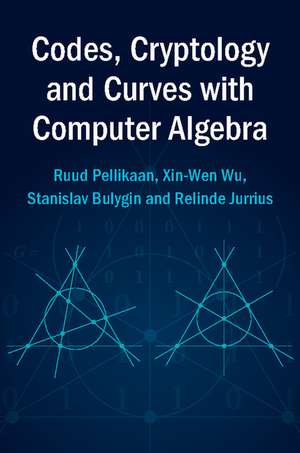Codes, Cryptology and Curves with Computer Algebra
Autor Ruud Pellikaan, Xin-Wen Wu, Stanislav Bulygin, Relinde Jurriusen Limba Engleză Paperback – noi 2017
| Toate formatele și edițiile | Preț | Express |
|---|---|---|
| Paperback (1) | 459.52 lei 3-5 săpt. | |
| Cambridge University Press – noi 2017 | 459.52 lei 3-5 săpt. | |
| Hardback (1) | 1097.16 lei 6-8 săpt. | |
| Cambridge University Press – noi 2017 | 1097.16 lei 6-8 săpt. |
Preț: 459.52 lei
Preț vechi: 516.32 lei
-11% Nou
Puncte Express: 689
Preț estimativ în valută:
87.96€ • 95.57$ • 73.93£
87.96€ • 95.57$ • 73.93£
Carte disponibilă
Livrare economică 31 martie-14 aprilie
Preluare comenzi: 021 569.72.76
Specificații
ISBN-13: 9780521520362
ISBN-10: 0521520363
Pagini: 606
Ilustrații: 30 b/w illus. 305 exercises
Dimensiuni: 152 x 227 x 31 mm
Greutate: 0.81 kg
Editura: Cambridge University Press
Colecția Cambridge University Press
Locul publicării:Cambridge, United Kingdom
ISBN-10: 0521520363
Pagini: 606
Ilustrații: 30 b/w illus. 305 exercises
Dimensiuni: 152 x 227 x 31 mm
Greutate: 0.81 kg
Editura: Cambridge University Press
Colecția Cambridge University Press
Locul publicării:Cambridge, United Kingdom
Cuprins
Preface Ruud Pellikaan; 1. Error-correcting codes Ruud Pellikaan and Xin-Wen Wu; 2. Code constructions and bounds on codes Ruud Pellikaan and Xin-Wen Wu; 3. Weight enumeration Relinde Jurrius, Ruud Pellikaan and Xin-Wen Wu; 4. Cyclic codes Ruud Pellikaan; 5. Polynomial codes Ruud Pellikaan; 6. Algebraic decoding Ruud Pellikaan and Xin-Wen Wu; 7. Complexity and decoding Stanislav Bulygin, Ruud Pellikaan and Xin-Wen Wu; 8. Codes and related structures Relinde Jurrius and Ruud Pellikaan; 9. Cryptology Stanislav Bulygin; 10. Gröbner bases for coding and cryptology Stanislav Bulygin; 11. Codes on curves Ruud Pellikaan; 12. Coding and cryptology with computer algebra Stanislav Bulygin; References; Index.
Recenzii
'The book under review is intended as an introduction to the field for beginning graduate students. The authors do a good job of covering a wide range of topics and keeping the discussion detailed while still as elementary as one can hope to make it.' Darren Glass, MAA Reviews
'While 'coding' may commonly connote confidential communication and security for sensitive data, coding also enters the engineering of information transmission and retrieval, simply for efficient resilience against mechanical error and corrupting noise. From these two purposes rise the two distinct subjects of cryptology and error-correction, receiving here an unusual, unified treatment. Good codes spring from diverse directions, since so many branches of mathematics inform their development: combinatorics, linear algebra, finite fields, ring theory, algebraic geometry, and computer algebra. The girth of this volume reflects the reasonably detailed exposition of all this background material, most of it likely new to engineering students (but students of pure mathematics should also read this book for practical applications of seemingly abstract material they have likely studied). The authors maintain a high level of rigor, keeping all proofs short by astute organization without ever stinting on detail.' D. V. Feldman, Choice
'This book provides a fine exposition of the topics to those students who are novices to the field. At the same time it will also be of interest to readers who are already familiar with some of the concepts discussed in the book. It provides a valuable schematic summary and consolidated overview of the field.' S. V. Nagaraj, SIGACT News
I was impressed by the scope of the book: many topics in algebraic coding theory are addressed and now collected in one book. Someone reading the entire book, will obtain a very good overview of algebraic coding theory. Peter Beelen, Nieuw Archief voor Weskunde
'While 'coding' may commonly connote confidential communication and security for sensitive data, coding also enters the engineering of information transmission and retrieval, simply for efficient resilience against mechanical error and corrupting noise. From these two purposes rise the two distinct subjects of cryptology and error-correction, receiving here an unusual, unified treatment. Good codes spring from diverse directions, since so many branches of mathematics inform their development: combinatorics, linear algebra, finite fields, ring theory, algebraic geometry, and computer algebra. The girth of this volume reflects the reasonably detailed exposition of all this background material, most of it likely new to engineering students (but students of pure mathematics should also read this book for practical applications of seemingly abstract material they have likely studied). The authors maintain a high level of rigor, keeping all proofs short by astute organization without ever stinting on detail.' D. V. Feldman, Choice
'This book provides a fine exposition of the topics to those students who are novices to the field. At the same time it will also be of interest to readers who are already familiar with some of the concepts discussed in the book. It provides a valuable schematic summary and consolidated overview of the field.' S. V. Nagaraj, SIGACT News
I was impressed by the scope of the book: many topics in algebraic coding theory are addressed and now collected in one book. Someone reading the entire book, will obtain a very good overview of algebraic coding theory. Peter Beelen, Nieuw Archief voor Weskunde
Notă biografică
Descriere
Graduate-level introduction to error-correcting codes, which are used to protect digital data and applied in public key cryptosystems.
